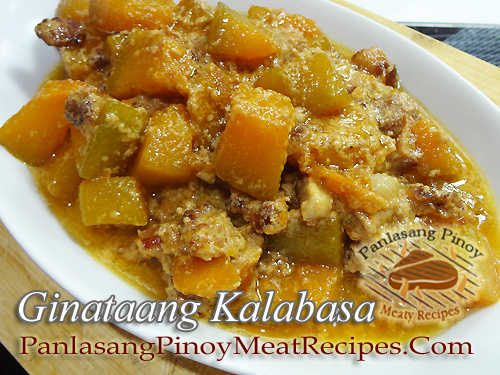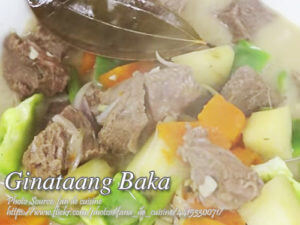Are you looking for a simple and flavorful vegetable recipe? Look no further than ginataang kalabasa, also known as squash with coconut milk. This delightful Filipino dish combines the natural sweetness of squash with the richness of coconut milk, creating a satisfying and nutritious meal. In this recipe blog post, we will guide you through the process of cooking ginataang kalabasa, sharing helpful tips along the way. This recipe has more pork in it, half of the amount of squash so it is more meaty.
Choosing the Perfect Squash
Before we dive into the cooking process, let’s talk about selecting the right squash for your ginataang kalabasa. To ensure a tender and flavorful dish, opt for young squash with a greenish-colored peel. The flesh of young squash should be yellow, with a slight greenish hue on the edges. Avoid squash with dark orange flesh, as it tends to be mature and has tough fibers. By choosing the right squash, you’ll guarantee a delectable outcome for your ginataang kalabasa.
Preparing the Ingredients
To start, wash the squash thoroughly and peel off the skin. Remove the seeds and slice the squash into 1-inch pieces. Set the sliced squash aside while we move on to the next steps.
Sautéing the Aromatics
Heat some oil in a wok and sauté a combination of garlic, onion, and tomato. The aroma that fills your kitchen will make your mouth water in anticipation of the delicious dish to come. Sauté until the onion and tomato are cooked to perfection, releasing their flavors and enhancing the overall taste of the ginataang kalabasa.
Adding the Meaty Goodness
Once the aromatics are cooked, it’s time to add the pork belly. Stir-fry the pork until it turns a light brown color, infusing it with the delightful flavors of the sautéed ingredients. The combination of pork and squash creates a meaty and satisfying dish, perfect for those looking for a hearty meal.
Enhancing the Flavor
To take your ginataang kalabasa to the next level, add shrimp paste to the wok. This ingredient adds a unique umami flavor to the dish, complementing the sweetness of the squash and the richness of the coconut milk. Stir-fry the ingredients for a few more minutes, allowing the flavors to meld together.
Simmering in Coconut Milk
Now, it’s time to add the star ingredient—coconut milk. For the best results, opt for fresh coconut milk, which is often available in wet markets. You can also make your own by extracting grated mature coconuts, although it may require some effort. The freshness of the coconut milk will enhance the overall taste of the dish, making it truly exceptional. It is a little tedious but the taste is worth the effort.
Once you’ve poured the coconut milk into the wok, add some magic sarap seasoning to elevate the flavors even further. Allow the mixture to simmer gently until the squash is cooked to perfection. The creamy coconut milk will infuse every piece of squash with its rich, velvety texture, creating a harmony of flavors that will tantalize your taste buds.
Serving and Enjoying
Congratulations! You have successfully cooked ginataang kalabasa. Now, it’s time to savor the fruits of your labor. This dish is best enjoyed with steamed rice, which will help balance the richness of the coconut milk and provide a satisfying contrast in flavors. Each spoonful of ginataang kalabasa will bring a burst of flavors to your palate, with the creamy coconut milk, tender squash, and succulent pork tantalizing your taste buds.
Wrap-Up
Ginataang kalabasa is a simple yet incredibly flavorful Filipino dish that combines the natural sweetness of squash with the richness of coconut milk. By selecting the right squash, sautéing the aromatics, adding the meaty goodness, and simmering it all together in coconut milk, you can create a delicious and satisfying meal that will leave you craving more. So, gather your ingredients, follow the steps we’ve outlined, and indulge in the delightful flavors of ginataang kalabasa. Your taste buds will thank you!
How to Cook Ginataang Kalabasa (Squash with Coconut Milk)
Ingredients
- 1/2 kilo squash
- 1/4 kilo pork belly liempo, slice into cubes
- 2 cups coconut milk
- 1 Tbsp. shrimp paste bagoong alamang
- 2 Tbsp. cooking oil
- 2 cloves garlic minced
- 1 medium size red onion chopped
- 1 medium sized tomato chopped
- 1 tsp. Magic Sarap or any granulated seasoning
Instructions
How to Cook Ginataang Kalabasa
- Wash, peel and remove the seeds of the squash. Slice into 1 inch size then set aside.
- In an empty wok, heat oil and saute garlic, onion and tomato.
- When the onion and tomato is already cooked, add the pork belly and stir fry for a few minutes until the pork is light brown.
- Then add the shrimp paste and stir fry for a few minutes then add the squash.
- Stir fry again until the squash turns to bright yellow or orange depending on the kind of squash you bought.
- Then pour the coconut milk, add magic sarap seasoning and simmer until the squash is cooked.
Video
Notes
Cooking Tips of Ginataang Kalabasa Recipe:
- The Power of Pork Fat: When sautéing the pork belly for your ginataang kalabasa, render out some of the fat first. This step not only adds a depth of flavor to your dish but also helps to ensure that the pork cooks evenly and becomes tender.
- Layered Flavors with Shrimp Paste: Instead of adding the shrimp paste directly to the pot, try sautéing it separately until it becomes fragrant. Then, mix it into the dish towards the end of cooking. This technique allows the shrimp paste to impart a rich umami flavor without overpowering the other ingredients.
- Coconut Milk Magic: To enhance the coconut flavor of your ginataang kalabasa, try toasting the grated coconut in a dry pan until it turns golden brown before extracting the milk. This extra step adds a nutty undertone to the dish, elevating its overall taste.






Pwede iahlo instead of pork bely chicken liver?
Hi Nenie, yes I think you can use chicken liver. ðŸ˜
thanks so much, Manny! feel ko ang passion mo for cooking and sharing it with us. helpful tips too.
Hi Cora, thank you also for your time and effort for posting your comment. Maraming salamat!
Thanks for sharing your recipe, and it is very useful for an OFW like me who loves Filipino food.
Hi Noel, thanks also for giving time to write your comment! Cheers!
Hi pwde po bang wlang ihalong bagoong s pagluluto nito…?
Hi Raymond, yes pwede rin naman wag lagyan ng bagoong.
Hi Evelyn, you’re welcome!
a massive thank u bro.
Thanks for your ginataang kalabasa recipe and also for the tips of selecting squash. I thought they are all the same.
thank you for sharing all your recipes, a big big help for me. Thank you so much bro!